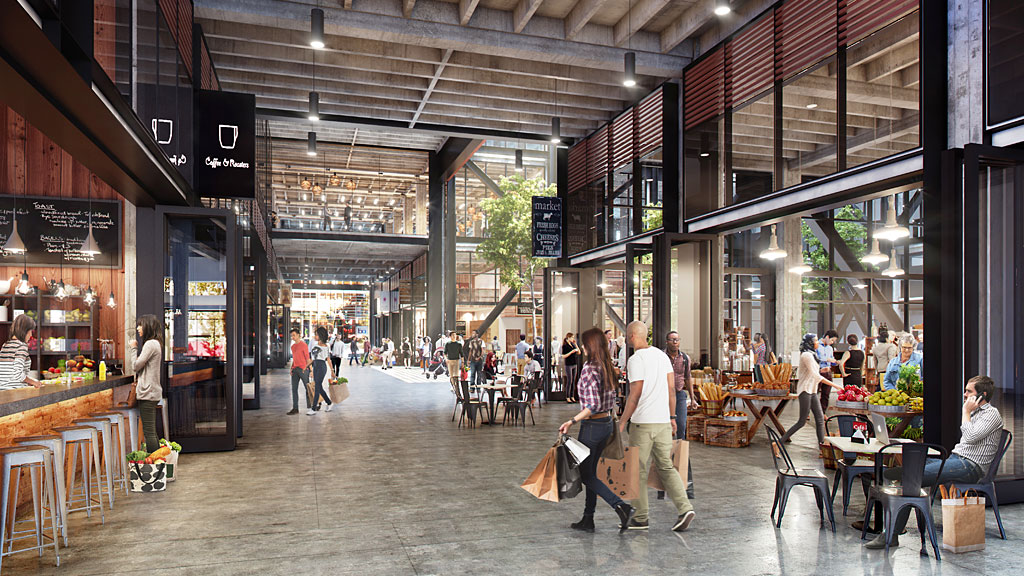“Why are these buildings empty?”
A client recently asked us this question in reference to an unleased project in the Bay Area, arguably the hottest real estate market in the country right now and the epicenter of the movement towards creative office. The answer to that question took us on a journey that culminated in “Spec for Tech,” a thought leadership presentation on how to build on spec for tech tenants.
Developers and owners are finding themselves in the midst of an attitude shift about the workplace, led by the tech industry and its predominantly millennial workforce. Tenants are looking for Places rather than offices - settings which blur the line between work and life, and where shared purpose is the new normal. For those developing corporate workplaces, this means that the traditional office building is obsolete. The new work environment is inspired by cities and the attributes that all great urban environments share: access, amenities, mobility and proximity.
“We are a tech firm!” This quote came from a financial services client, and has been echoed by other clients around the world, who think of themselves as tech companies. Banks, insurance companies, and even law firms identify as Tech, which has become a short-hand reference to the creative class that wants creative office space.
These firms share with the tech sector common aspirations for their employees and their workplace. In a market saturated with typical spec office space, innovative companies are looking for spaces that reflect their company culture and allow people to work together with a sense of shared purpose. As more companies embrace tech as their identity, the creative office will become their workplace of choice.
 Motorola Mobility office space reflects the company culture and values, and allows people to work together with a sense of shared purpose. Image: Eric Laignel (via GenslerOn).
Motorola Mobility office space reflects the company culture and values, and allows people to work together with a sense of shared purpose. Image: Eric Laignel (via GenslerOn).
“How do we get 2,500 people to collaborate?” Companies want their employees together in one location, and that is stretching the boundaries of the traditional campus. How much proximity and access do you need to maintain community, and what’s the breaking point? Connection is top of mind for creative tenants because exchanging knowledge and information among employees leads directly to innovation. It’s about more than using amenities in a war for talent, and it’s more than simply creating large floor plates.
Great office buildings have a lot in common with great cities: a sense of authenticity, culture, and identity. Spec buildings that provide creative office space will differentiate themselves and bring value to the market, to find among their tenants the growing number of firms who are proclaiming, “I am a tech firm!”
About the Author: Ben Tranel is compelled by his belief that architects are stewards of the built environment. As a Principal in the San Francisco office, his role leading architectural projects focuses on the artistry of craft, where a love of detail enhances the human enjoyment of the projects. Contact him at benedict_tranel@gensler.com.
More from Author
Gensler | Oct 21, 2024
3 surprises impacting the return to the office
This blog series exploring Gensler's Workplace Survey shows the top three surprises uncovered in the return to the office.
Gensler | Jun 26, 2024
5 ways ESG can influence design and create opportunities
Gensler sustainability leaders Stacey Olson, Anthony Brower, and Audrey Handelman share five ways they're rethinking designing for ESG, using a science-based approach that can impact the ESG value chain.
Gensler | May 20, 2024
10 spaces that are no longer optional to create a great workplace
Amenities are no longer optional. The new role of the office is not only a place to get work done, but to provide a mix of work experiences for employees.
Gensler | Apr 15, 2024
3 ways the most innovative companies work differently
Gensler’s pre-pandemic workplace research reinforced that great workplace design drives creativity and innovation. Using six performance indicators, we're able to view workers’ perceptions of the quality of innovation, creativity, and leadership in an employee’s organization.
Gensler | Mar 13, 2024
Trends to watch shaping the future of ESG
Gensler’s Climate Action & Sustainability Services Leaders Anthony Brower, Juliette Morgan, and Kirsten Ritchie discuss trends shaping the future of environmental, social, and governance (ESG).
Gensler | Feb 15, 2024
5 things developers should know about mass timber
Gensler's Erik Barth, architect and regional design resilience leader, shares considerations for developers when looking at mass timber solutions.
Gensler | Jan 15, 2024
How to keep airports functional during construction
Gensler's aviation experts share new ideas about how to make the airport construction process better moving forward.
Gensler | Dec 18, 2023
The impacts of affordability, remote work, and personal safety on urban life
Data from Gensler's City Pulse Survey shows that although people are satisfied with their city's experience, it may not be enough.
Gensler | Nov 16, 2023
How inclusive design supports resilience and climate preparedness
Gail Napell, AIA, LEED AP BD+C, shares five tips and examples of inclusive design across a variety of building sectors.
Gensler | Oct 16, 2023
The impact of office-to-residential conversion on downtown areas
Gensler's Duanne Render looks at the incentives that could bring more office-to-residential conversions to life.
















